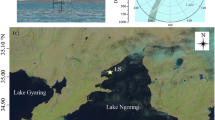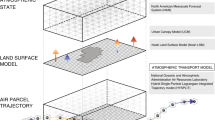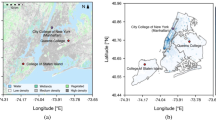Abstract
A steady-state, two-dimensional numerical model is used to simulate air temperatures and humidity downwind of a lake at night. Thermal effects of the lake were modelled for the case of moderate and low surface winds under the cold-air advective conditions that occur following the passage of a cold front. Surface temperatures were found to be in good agreement with observations. A comparison of model results with thermal imagery indicated the model successfully predicts the downwind distance for which thermal effects due to the lake are significant.
Similar content being viewed by others
Abbreviations
- f :
-
Coriolis parameter
- g :
-
Acceleration of gravity
- K :
-
Turbulent eddy coefficient
- M :
-
Moisture availability parameter
- Q rad :
-
Net long-wave absorbed radiation
- q :
-
Specific humidity
- t :
-
Time
- Ug :
-
Geostrophic wind
- u,v,w :
-
Horizontal, crosswind, and vertical velocity components
- x,y,z :
-
Horizontal and vertical coordinates
- ζ :
-
Vorticity
- θ :
-
Potential temperature
References
Allen, L. H.: 1975, ‘Line-Source Carbon Dioxide Release’,Boundary-Layer Meteorol. 8, 39–79.
Bill, R. G., Jr., Sutherland, R. A., Bartholic, J. F., and Chen, E.: 1978 ‘Observations of the Convective Plume of a Lake Under Cold Air Advective Conditions’,Boundary-Layer Meteorol. 14, 543–556.
Blackadar, A. K.: 1962, ‘The Vertical Distribution of Wind and Turbulent Exchange in Neutral Atmosphere’,J. Geophys. Res. 67, 3095–3102.
Chang, J. H.: 1968, Climate and Agriculture Aldine Publishing Co., Chicago, 304 pp.
Gerber, J. F. and Hashemi, F.: 1965, ‘The Freezing Point of Citrus Leaves’,Proc. Amer. Sec. Hort. Sci. 86, 220–225.
Gutman, D. P., Torrance, K. E., and Estoque, M. A.: 1973, ‘Use of the Numerical Method of Estoque and Bhunralkar for the Planetary Boundary Layer’,Boundary-Layer Meteorol. 1, 169–194.
Gutman, D. P.: 1974, ‘Heat Rejection and Roughness Effects on the Planetary Boundary Layer Above Cities’, Ph. D. Thesis, Cornell University, Ithaca, New York. 223 p.
Gutman and Torrance, K. E.: 1975, ‘Response of the Urban Boundary Layer to Heat Addition and Surface Roughness’, Boundary-Layer Meteorol.9, 217–233.
Kraus, E. D.: 1972,Atmosphere-Ocean Interaction, Clarendon Press, Oxford, 275 p.
Pielke R. A. 1974, ‘A Three-Dimensional Numerical Model of the Sea Breeze Over South Florida’.Mon. Weather Rev. 102, 115–139.
Puffer, R. E. and Turrell, F. M.: 1967, ‘Frost Protection in Citrus’. Univ. of Ca. Agric. Ext. Ser., AXT-108, 8 p.
Van Wijk, W. R., ed.: 1963, Physics of Plant Environment, North-Holland Publishing Co., Amsterdam.
Zdunkowski, W. G., and Johnson, F. G., 1965: ‘Infrared Flux Divergence Calculations with Newly constructed Radiation Tables’.J. Appl. Meteor.,4, 371–377.
Author information
Authors and Affiliations
Rights and permissions
About this article
Cite this article
Bill, R.G., Chen, E., Sutherland, R.A. et al. Simulating the moderating effect of a lake on downwind temperatures. Boundary-Layer Meteorol 16, 23–33 (1979). https://doi.org/10.1007/BF02220404
Accepted:
Issue Date:
DOI: https://doi.org/10.1007/BF02220404




